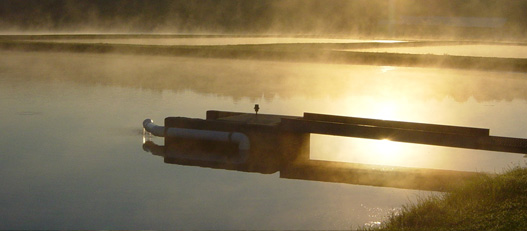- East Fork State Fish Hatchery Alerts
- None at this time.

5807 E. 825 South
Montgomery, IN; 47558
812-644-7717
on.IN.gov/eastfork-sfh
Get Directions
- Hours/History
Hours
- Monday – Friday 7 a.m. – 3 p.m.
(Off property commitments may alter hours)
History
East Fork Hatchery is the newest cool and warm water hatchery to be constructed in Indiana since the 1940s. The hatchery takes its name from the nearby East Fork of the White River. Construction started in February 1982 and was completed in July 1983 at a cost of $2.7 million. The hatchery construction was financed from the sale of hunting and fishing licenses. The hatchery covers about 80 acres and contains 29 earthen ponds ranging from ½ to 6 acres in size. The ponds total 33 acres of water.
One of the unique characteristics of the East Fork Hatchery is that this facility was originally designed to be able to experiment with, and respond to, the various fish culture options that were emerging during the construction of this hatchery. Over time, pond configurations have changed here at East Fork, to meet the Indiana DNR’s fish production needs. For this reason, there are various aquaculture methods used on this property, including internal and external raceway systems, as well as a variety of pond configurations.
The water supply is the 1,400-acre Dogwood Lake, located on Glendale Fish & Wildlife Area. Water is gravity fed from depths of 7 and 30 feet to eliminate pumping costs. Water temperature is controlled by valves which blend water from the two levels. The water is then screened to remove debris, aerated, and directed to either the ponds or the production building. More than 2,000 gallons of water per minute can be drawn from the lake. A standby generator provides power to the facility in emergency situations.
Being a State-owned facility, all fish reared at East Fork Hatchery are stocked into public waters accessible to all individuals who purchase an Indiana fishing license. People interested in purchasing fish for private ponds can contact any number of private hatcheries throughout the state.Indiana state fish hatcheries do not sell fish.
- Monday – Friday 7 a.m. – 3 p.m.
- Fish Culture
Sport fish reared at the East Fork Hatchery include walleye, hybrid walleye, striped bass, hybrid striped bass, muskellunge, channel catfish, largemouth bass, and overwintered southern spring stocked rainbow trout. Fathead minnows are also reared for forage feeding.
With the exception of muskellunge and rainbow trout, all fish are reared in earthen ponds. Ponds are fertilized before being stocked to ensure ample plankton (microscopic plants and animals) are available; which serve as food for small fish. Additional food is supplied by either continued pond fertilization, feeding a commercial fish feed or, in the case of muskellunge, stocking forage fish.
Muskellunge, also known as muskie, are the only fish that arrive at the hatchery as eggs. When the eggs hatch and the fry have reached their swim-up stage, the muskie are then placed in long, shallow starter troughs for care and maintenance. Feeding in the production room consists of a commercial diet; the size of which starts similar to talcum powder and advances to larger pellets as the fish grow. Feed is automatically dispensed at set times to the muskie via specialized fish feeders.
As the muskie grow, they are placed into deeper linear tanks. The fish are inventoried periodically and can be separated into other tanks to avoid overcrowding. In the fall, young muskie are placed into outside ponds to feed on fathead minnows for their final 30 days at the hatchery. This ensures that the fish will have greater success in finding natural food sources once stocked into Indiana waters.
- Production
Production Building
The production building houses egg incubation and intensive production facilities. This consists of hatching jars, vertical flow egg incubation trays and 20-foot rearing tanks. The production room is equipped with an ultraviolet (UV) sterilizer, sand filter, controlled heating and lighting, and automatic fish feeders. The tanks are also used to sort and hold fish coming in from the production ponds, prior to being shipped across the state. The building also houses a laboratory, offices, a locker room, a work shop, storage space and public rest rooms.
Rearing Raceways
Both inside and outside raceways are used to rear fish from the fry stage to fingerling or larger sizes. Equipped with automatic feeders, the inside raceways afford a controlled environment for up to 70,000 muskellunge. Each winter through early spring, the outside raceways hold approximately 5,000 rainbow trout fingerlings for southern Indiana spring trout stockings.
Production Ponds
The three 2-acre, sixteen 1-acre, two ¾-acre, and seven ½-acre ponds can be used to rear all fish species to stocking size. Walleye, striped bass and their respective hybrids arrive as newly hatched fry and spend 30 to 35 days in the ponds. They are stocked out at approximately 1.5 to 2-inches fingerlings. Channel catfish arrive as fingerlings and are raised in the ponds for 4 to 5 months, being stocked out in the 8 to 10-inch size range. Largemouth bass arrive as 2-inch fingerlings and are reared to 4-inch fish over a 5 month period. Muskie arrive as eggs and are reared for 7 months indoors as they progress through the fry and fingerling stages. In early fall they are stocked into the outdoor rearing ponds in the 7 to 8-inch range, for their 30-day forage finishing process. After the forage finishing, the muskie are usually stocked out in the 9 to 10-inch range.
Total production at East Fork will range between 1 million and 15 million fish annually, depending on management needs.
- Volunteer Opportunities
Need a reason to get outside and move? You can volunteer alone or in small groups at this property. Some activities include trash pick-up, basic gardening, painting, and more. Call the property office for details.

